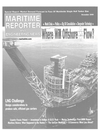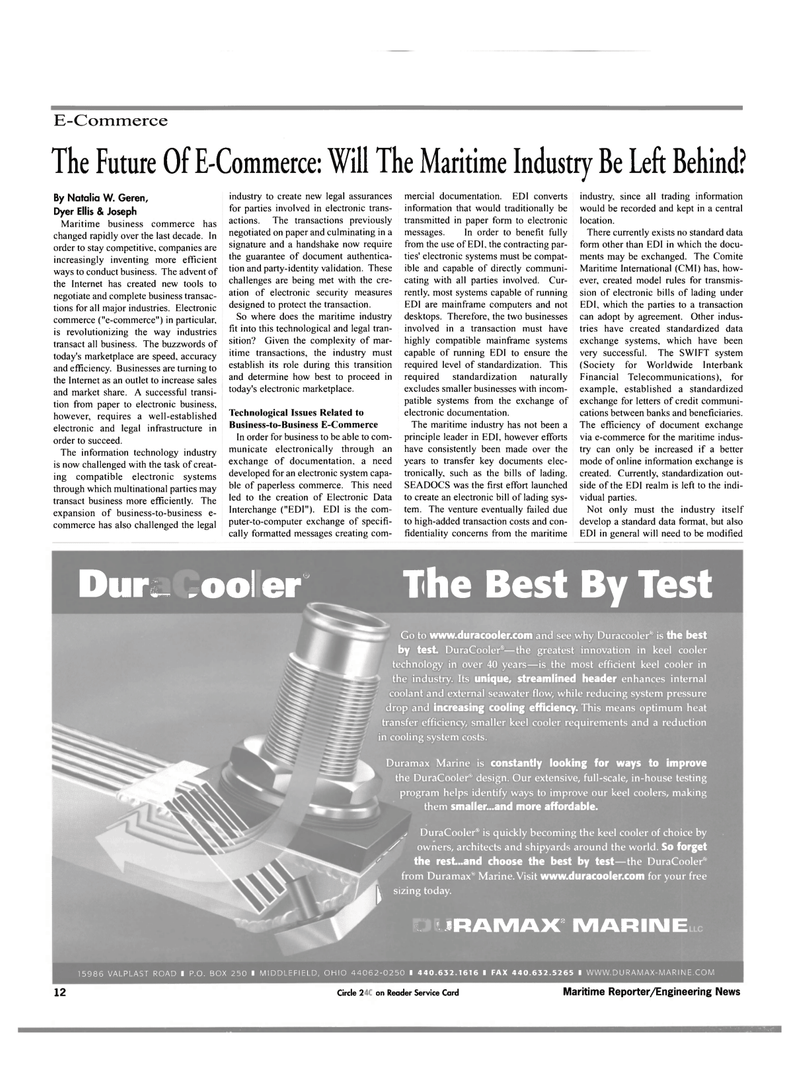
Page 14: of Maritime Reporter Magazine (November 2000)
Read this page in Pdf, Flash or Html5 edition of November 2000 Maritime Reporter Magazine
E-Commerce
The Future Of E-Commerce: Will The Maritime Industry Be Left Behind?
By Natalia W. Geren,
Dyer Ellis & Joseph
Maritime business commerce has changed rapidly over the last decade. In order to stay competitive, companies are increasingly inventing more efficient ways to conduct business. The advent of the Internet has created new tools to negotiate and complete business transac- tions for all major industries. Electronic commerce ("e-commerce") in particular, is revolutionizing the way industries transact all business. The buzzwords of today's marketplace are speed, accuracy and efficiency. Businesses are turning to the Internet as an outlet to increase sales and market share. A successful transi- tion from paper to electronic business, however, requires a well-established electronic and legal infrastructure in order to succeed.
The information technology industry is now challenged with the task of creat- ing compatible electronic systems through which multinational parties may transact business more efficiently. The expansion of business-to-business e- commerce has also challenged the legal industry to create new legal assurances for parties involved in electronic trans- actions. The transactions previously negotiated on paper and culminating in a signature and a handshake now require the guarantee of document authentica- tion and party-identity validation. These challenges are being met with the cre- ation of electronic security measures designed to protect the transaction.
So where does the maritime industry fit into this technological and legal tran- sition? Given the complexity of mar- itime transactions, the industry must establish its role during this transition and determine how best to proceed in today's electronic marketplace.
Technological Issues Related to
Business-to-Business E-Commerce
In order for business to be able to com- municate electronically through an exchange of documentation, a need developed for an electronic system capa- ble of paperless commerce. This need led to the creation of Electronic Data
Interchange ("EDI"). EDI is the com- puter-to-computer exchange of specifi- cally formatted messages creating com- mercial documentation. EDI converts information that would traditionally be transmitted in paper form to electronic messages. In order to benefit fully from the use of EDI, the contracting par- ties' electronic systems must be compat- ible and capable of directly communi- cating with all parties involved. Cur- rently. most systems capable of running
EDI are mainframe computers and not desktops. Therefore, the two businesses involved in a transaction must have highly compatible mainframe systems capable of running EDI to ensure the required level of standardization. This required standardization naturally excludes smaller businesses with incom- patible systems from the exchange of electronic documentation.
The maritime industry has not been a principle leader in EDI, however efforts have consistently been made over the years to transfer key documents elec- tronically, such as the bills of lading.
SEADOCS was the first effort launched to create an electronic bill of lading sys- tem. The venture eventually failed due to high-added transaction costs and con- fidentiality concerns from the maritime industry, since all trading information would be recorded and kept in a central location.
There currently exists no standard data form other than EDI in which the docu- ments may be exchanged. The Comite
Maritime International (CMI) has, how- ever, created model rules for transmis- sion of electronic bills of lading under
EDI, which the parties to a transaction can adopt by agreement. Other indus- tries have created standardized data exchange systems, which have been very successful. The SWIFT system (Society for Worldwide Interbank
Financial Telecommunications), for example, established a standardized exchange for letters of credit communi- cations between banks and beneficiaries.
The efficiency of document exchange via e-commerce for the maritime indus- try can only be increased if a better mode of online information exchange is created. Currently, standardization out- side of the EDI realm is left to the indi- vidual parties.
Not only must the industry itself develop a standard data format, but also
EDI in general will need to be modified
DuraCooier ® The Best By Test
Go to www.duracooler.com and see why Duracooler® is the best by test. DuraCooier®—the greatest innovation in keel cooler technology in over 40 years—is the most efficient keel cooler in the industry. Its unique, streamlined header enhances internal coolant and external seawater flow, while reducing system pressure drop and increasing cooling efficiency. This means optimum heat transfer efficiency, smaller keel cooler requirements and a reduction in cooling system costs.
Duramax Marine is constantly looking for ways to improve the DuraCooier® design. Our extensive, full-scale, in-house testing program helps identify ways to improve our keel coolers, making them smaller...and more affordable. x DuraCooier® is quickly becoming the keel cooler of choice by / owners, architects and shipyards around the world. So forget ' the rest..and choose the best by test—the DuraCooier® from Duramax® Marine. Visit www.duracooler.com for your free | sizing today.
DURAMAX6 MARINE 15986 VALPLAST ROAD I P.O. BOX 250 I MIDDLEFIELD, OHIO 44062-0250 I 440.632.1616 I FAX 440.632.5265 I WWW.DURAMAX-MARINE.COM 12 Circle 276 on Reader Service Card Maritime Reporter/Engineering News

 13
13

 15
15
